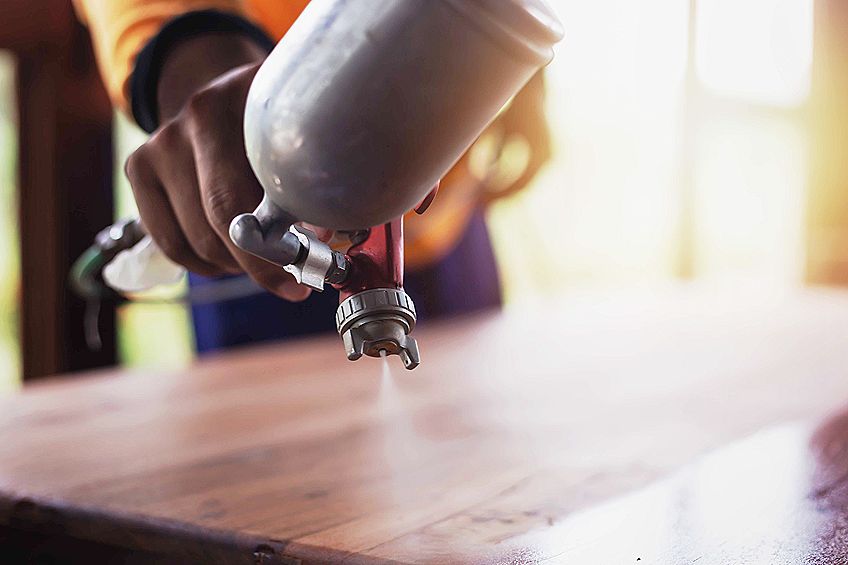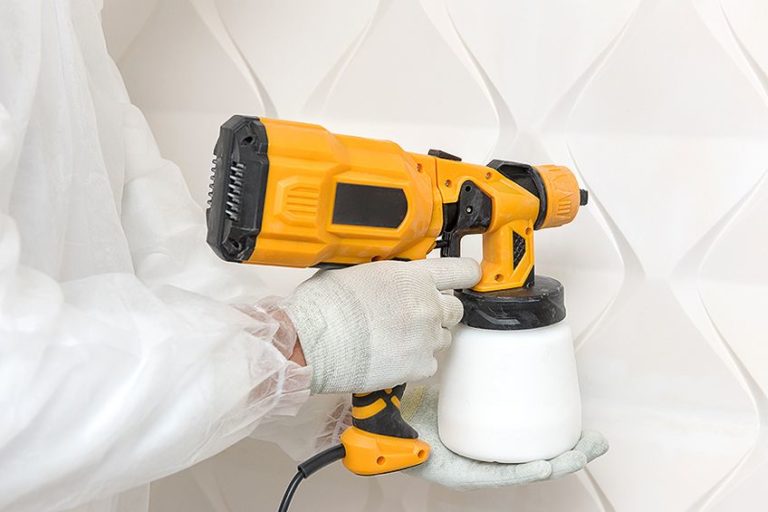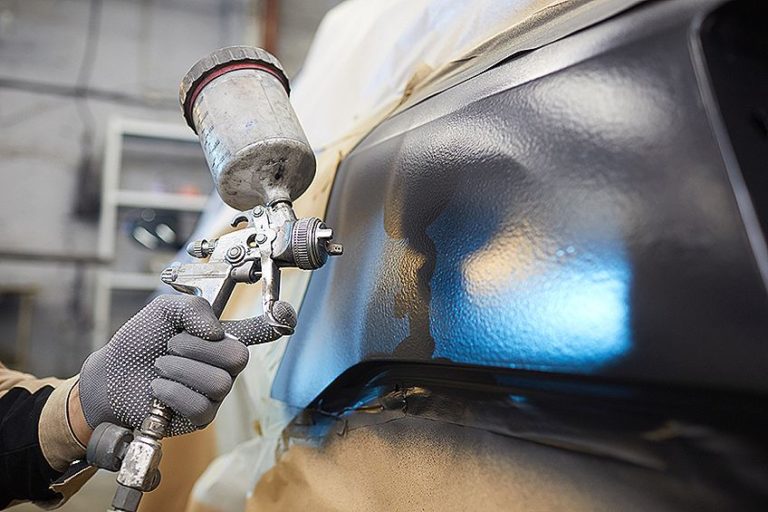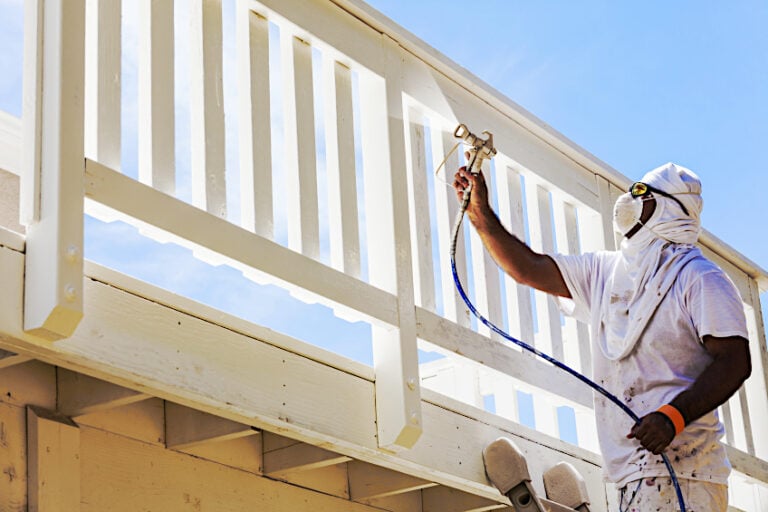Best Polyurethane Spray – Guide for Spraying Polyurethane
This post may contain affiliate links. We may earn a small commission from purchases made through them, at no additional cost to you.
Polyurethane is a type of liquid plastic that, once dried, forms an extremely hard and durable layer that is able to protect many different surfaces. You get both oil- and water-based polyurethane, each of which can either be brushed or sprayed onto a surface. This guide will focus on polyurethane spray, our recommended products, as well as how to apply this special coating.
Table of Contents
Why is It Better to Spray Polyurethane?
Most people tend to try to apply their polyurethane with a brush, which can make it more difficult to achieve a perfect finish. This is because the act of stirring the paint or wiping the edge of the can with the brush will result in bubbles, which will show in the final finish. To avoid bubbles when brushing polyurethane, you have to work slowly and precisely in order to ensure a smooth and even surface. The incorrect brushing technique can also trap moisture in the paint, resulting in a cloudy, white finish as opposed to one that is crystal-clear.
Spraying polyurethane, on the other hand, eliminates the need for a precise technique, making it much easier to use. While a few additional steps are required for spraying polyurethane, the extra effort will result in a beautiful finish that can be achieved with little to no mistakes.

Selecting a Suitable Spray Can Polyurethane
There are several things that need to be kept in mind when choosing the right spray polyurethane for your project. You will need to consider whether you would prefer an oil- or water-based polyurethane spray, how long it will take to dry, as well as the end-result.
Oil- versus Water-Based Polyurethane Spray
Before you can select a product, you will need to know whether you are looking for an oil-based or water-based polyurethane. The key difference between the two is simple: one has a water base and the other an oil base, which means that one may be more suitable for a particular project than the other. Water-based polyurethanes also tend to be much clearer and more transparent than oil-based options, which usually have a warm, amber hue. Water-based products also will not yellow over time.
Thus, you will be better off with a water-based polyurethane for lighter woods, whereas oil-based is great for enhancing the color of a darker wood. Finally, the composition of a water-based polyurethane means that it produces fewer volatile organic compounds (VOCs) and toxic fumes than oil-based ones, making them better for the environment. However, this also means that water-based polyurethanes are not as durable or as long-lasting as their oil-based counterparts.
Thus, whether you use an oil- or water-based polyurethane will depend entirely on the project itself, the type pf wood you are using, as well as the end-result you wish to achieve.
Drying Time
When it comes to the drying time of a polyurethane product, you will need to take into account the length of time it will take to dry to the touch, as well as how long to wait before you can apply another coat. Water-based polyurethanes tend to take less time to dry than oil-based options, so your choice will depend on the nature of your project and how long you are willing to wait. In general, a water-based polyurethane will take a couple of hours before a new coat can be applied. Oil-based polyurethanes require anywhere between 5 and 12 hours to dry completely.
Final Finish
Regarding the final finish of your polyurethane coating, you will once again have to decide between an oil- or water-based spray. Water-based polyurethanes are thinner and therefore require more coats. The finish will be crystal-clear and should not yellow, although it may not offer the greatest durability. Oil-based polyurethanes, on the other hand, can be applied in fewer coats due to the thicker consistency of this product. The finish will be much more durable, but will add an amber hue to the natural color of your wooden surface.
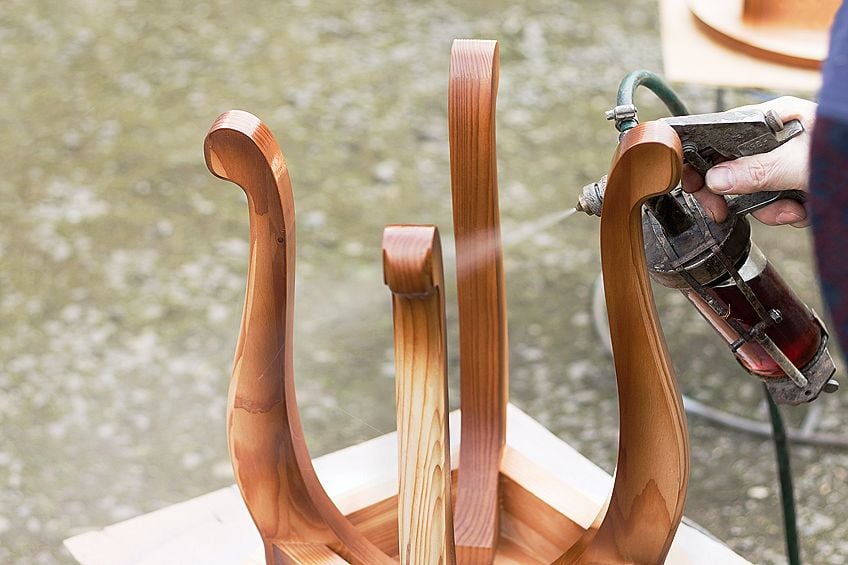
Best Polyurethane Spray
There are many various polyurethane sprays available on the market, which can turn the act of choosing a product into an overwhelming one. We have selected three of the best polyurethane spray products available from which you can choose the best option for your particular project.
Best Overall: MINWAX Fast-Drying Polyurethane Aerosol
This oil-based spray polyurethane will cause your indoor wooden surfaces to remain beautiful for longer due to the durability of this coating. You can use this product to protect all kinds of wooden furniture and surfaces in order to achieve a hard, clear, and semi-gloss finish. This product is quick to dry and can be applied to both finished and unfinished wooden surfaces, provided that they are based indoors. The polyurethane spray is easy to use and requires little maintenance once applied.
- Ideal for woodworking, furniture, doors, cabinets and floors
- Dries fast and offers long lasting beauty
- Long-lasting, durable finish
Pros
- This is a highly durable product.
- It is easy to use.
- This product offers great value for money.
- The coating will dry quickly.
- Your wooden surface will be left with an attractive, semi-gloss finish.
Cons
- This product can only be used indoors.
Premium Pick: RUST-OLEUM Varathane Polyurethane Spray
This is a water-based polyurethane spray, which means that it dries more quickly and can be cleaned easily with some soap and water. You can use this spray on interior surfaces only, where it will offer a clear, semi-gloss coating that will prevent stains and scratches. One polyurethane spray can will cover up to 25 square feet of surface, and will dry within just half an hour. You should be able to apply the next coat after just one hour. This product emits a low odor when used and will leave behind a crystal-clear finish that not only resists stains and scratches, but it will also never yellow.
Pros
- The spray is quick-drying.
- You can clean it up with a simple soap-and-water solution.
- The finish is crystal-clear and will not yellow.
- The coating is highly durable and will resist stains and scratches.
- The product has a low odor when working with it.
Cons
- This product is for interior surfaces only.
- The nozzle can cause difficulties.
Budget-Friendly: MINWAX Helmsman Spar Urethane Aerosol
This is an oil-based polyurethane aerosol product that is ideal for use on both indoor and outdoor furniture. This is because it is formulated with UV blockers that prevent the sun from causing the finish to fade or become yellow over time. With a crystal-clear finish, a quick drying time, and easy clean-up, this product offers excellent value for a low price. This is a water-resistant polyurethane that also possesses special oils that will enable the finish to contract and expand with the wood as it responds to temperature changes. The coating is also resistant to cracks and chips.
Pros
- This product can be used both indoors and outdoors.
- The polyurethane is UV- and water-resistant.
- The coating is resistant to chips and cracks.
- The polyurethane dries quickly and is easy to clean.
- The product consists of special oils to allow the finish to adjust with the wood.
Cons
- The nozzle is prone to blockage.
Best Polyurethane Sprayer: HOMERIGHT Paint Sprayer
If you would prefer to thin your own polyurethane as opposed to using it in an aerosol can, you will require a suitable paint sprayer. We suggest using HomeRight’s Super Finish Max paint sprayer for an easy-to-use product that will provide a professional finish on all of your surfaces. This spray gun is ideal as it can be adjusted according to your needs, allowing you to achieve horizontal, vertical, and round spray patterns. You can also adjust the flow and output of the spray, allowing for maximum control.
- Paint sprayer for countless DIY projects
- Adjustable settings
- Powerful 450-watt spraying experience
This is the ideal spray gun for both small and large projects due to its 450-wattage. The high wattage means that you will have to spend much less time on thinning your polyurethane, as it can handle much thicker consistencies. It can be used with a variety of materials, including both water- and oil-based polyurethanes, and simply needs to be cleaned accordingly after each use. The sprayer also includes three brass spray tips to allow for even greater precision.
Pros
- You will not have to thin the polyurethane as much due to the high wattage of the spray gun.
- This is a versatile sprayer that can tackle any number of projects.
- The spray gun can hold a large quantity of product and does not require a compressor.
- It is fast to use and easy to clean.
- The gun is customizable and adjustable to achieve the perfect spray and finish.
Cons
- This product is quite pricey.
- Clean-up can be difficult.
How to Spray Polyurethane
Although the act of spraying polyurethane proves to be more effective than that of brushing, first you will need to master your technique. We have put together some detailed directions on how to go about spraying polyurethane in order to achieve the best possible finish.

Preparing the Polyurethane
If you have chosen to use a spray can polyurethane product, you will not need to perform this step. If, however, you plan on using normal polyurethane in a spray gun, you will need to use a thinner so as to reduce the viscosity of the liquid. This is because you will not be able to spray polyurethane with ease unless it is of a thin enough consistency.
- To thin your polyurethane, you will need to consult the manufacturer’s technical data sheet in order to find a suitable thinner. You can also look for a good cleaner, as these can also be used to thin a substance.
- The amount of thinner you need will vary depending on the type of polyurethane and the air pressure of the spray gun. Typically, you will require 10% of thinner in order to reduce your polyurethane to the point that it can be used in a spray.
Preparing the Surface
You cannot begin using polyurethane until your piece and working areas are prepared.
- Ensure that your wooden piece is ready to receive a protective coat by sanding it until it is smooth and even. Fill in any gaps, holes, and cracks, after which you can then apply a paint or stain of your choice. Allow everything to dry completely.
- Prepare your surface by making sure that it is free of any dust, dirt, and other forms of contamination. Use a clean cloth to wipe the surface of any contaminants, ensuring that the surface is completely clean before applying the polyurethane.
Selecting Your Tool for Spraying Polyurethane
You can choose to use a polyurethane that has been pre-prepared and comes in an aerosol spray can, or you can choose to thin the polyurethane yourself and use it with a suitable spraying tool.
- Your tool must have a tip between 1 and 5 inches wide, as this is the best size for not only polyurethane but many other finishes as well. Most spray guns should come with a few different tips from which to choose, although you can also purchase tips online or from your nearest hardware store.
- Adjust the volume control of the spray gun. You will need to experiment with this a little, as you will need to find the perfect setting that allows the polyurethane to be sprayed evenly with each coating.
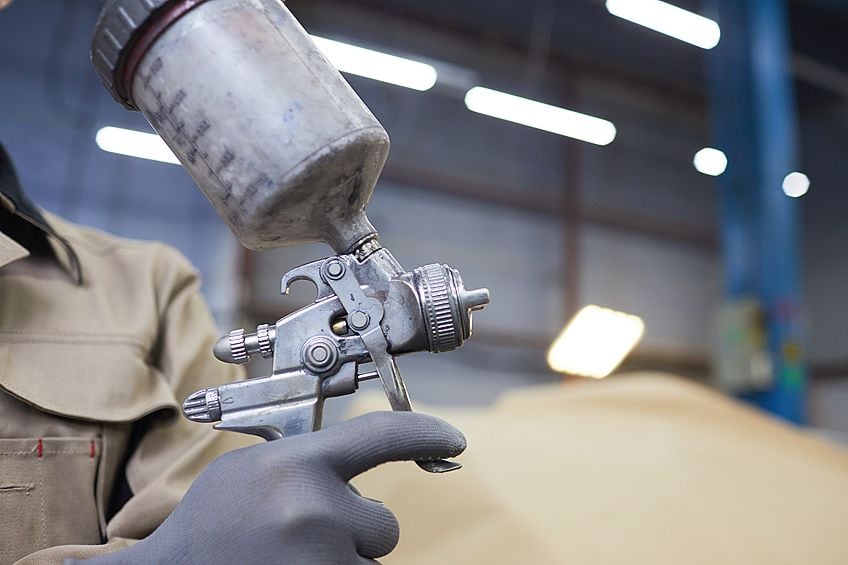
Spraying Polyurethane
The technique for spraying polyurethane may be difficult at first, but once mastered, you will be able to achieve the perfect polyurethane finish every time.
- When spraying, ensure that you keep the nozzle at least 10 to 12 inches away from the surface. Doing this will ensure an even coat without any bumps.
- Maintain a long, continuous movement when spraying, as stopping and starting in the middle of a coat will result in an uneven finish. More polyurethane in some places and less in others can result in drips and runs.
- You can ensure a smooth, even finish by keeping your wrist stiff and steady when spraying. You may be inclined to bend your wrist as you spray, but this can cause arcs instead of straight lines, which will once again result in an uneven finish.
- Spray the entire area of a surface in one motion before stopping. Do this for each individual layer.
- Acquaint yourself with your spray gun, as you will need to know which setting to use for various parts of your project. Most good brands should offer a product that comes with several settings that can be adjusted quickly.
We suggest using the vertical setting to spray surfaces such as table legs, columns, and pegs. The horizontal spray is great for moving across a flat area, whereas the circular or middle spray is ideal for covering corners, detailed curves, and edges.
Finishing Off
Once you have finished using your spray can polyurethane, you must allow the finish to dry completely.
- Remember that oil-based polyurethanes will take longer to dry than those with a water base. Once dry, you can use some water to clean your surface.
How to Spray Water-Based Polyurethane
Many people prefer spraying water-based polyurethane due to the lower health and environmental risks, as these products emit fewer toxic fumes and smells. However, it can be more difficult to apply a water-based polyurethane spray than an oil-based one.
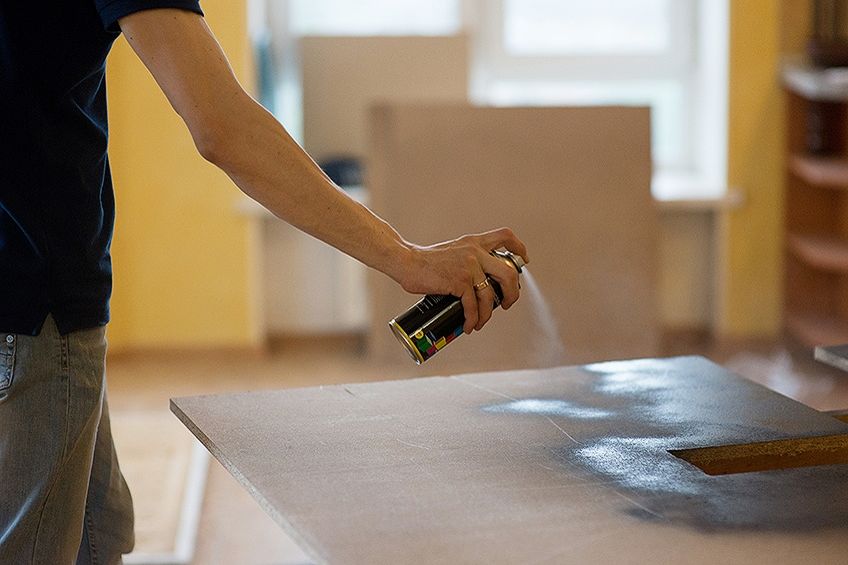
While the action of spraying the gun over an entire area with long, steady movements remains the same, you will need to take some additional factors into consideration when using a spray water-based polyurethane.
- Be diligent in order to avoid staining unwanted surfaces. Before you begin, cover your workspace and ensure that your piece is sanded and prepared sufficiently.
- Water-based polyurethanes do not atomize easily, despite their thinner consistency. This is especially so when the polyurethane itself is cold. We suggest using an air-assisted or airless spray gun in order to achieve the best atomization for your water-based polyurethane. You can also thin the water-based solution in order to improve atomization.
- You will require more coats when using a water-based polyurethane. Each layer must be left to dry completely before another can be applied. You can use heat or increased airflow in order to speed up the drying process between coats.
Spraying polyurethane is a great way to achieve a perfect, professional-looking finish on any of your wooden surfaces. With this guide, you should now be able to select the right type of polyurethane for your project and be able to use it with ease!
Frequently Asked Questions
What is the Purpose of Polyurethane Spray?
Polyurethane is often used as a clear, protective coating for a variety of surfaces due to its high level of durability.
Should I Brush On or Spray Polyurethane?
Brush-on polyurethanes are best used for flat surfaces, as this is where it is most important to build up the layer of film. Spray-on polyurethanes are great for difficult-to-reach areas and vertical or oddly-shaped surfaces, although you will have to develop your technique so as to avoid drips and overspray.
Do I Have to Thin My Polyurethane Spray?
Polyurethane is renowned for its durability as a protective coating, which means that the liquid itself is quite thick and honey-like. This means that you will likely require a thinner before spraying your polyurethane. We suggest testing the polyurethane without the thinner first to see its consistency, after which you can decide whether or not you need to add thinner. You can use turpentine, paint thinner, mineral spirits, and even water to thin your polyurethane.
What Kind of Sprayer Can I Use with Polyurethane?
You can use most standard sprayers for polyurethane, although many spray polyurethane products do come in an aerosol can. If you use another sprayer, such as an airbrush, you must ensure that you clean it properly in-between uses.
Should I Sand Between Polyurethane Spray Coats?
While you do not necessarily have to sand between coats of polyurethane, it is always advisable as it will increase the adhesion between the individual polyurethane layers, thus resulting in a finish that is smoother and more even. You must ensure that each coat has dried fully before attempting to sand the surface. Use a fine 320-grit piece of sandpaper that has been wrapped around a wooden block or something similarly hard. The first coat will always require the most sanding in order to appear smooth, and you should never sand the final coat.
Larissa Meyer is a 32-year-old mother from Michigan and creative spirit since childhood. Her passion for painting and drawing has led her to an education as an illustrator and a career as a freelance graphic designer. She has a Bachelor of Fine Arts in Illustration and a degree in Graphic Design. Larissa is a talented artist who is able to master a wide range of styles and techniques to bring her artistic vision to life. Her greatest passion is currently fluid painting and epoxy resin art. Larissa’s love for art and her knowledge and experience in illustration make her the perfect Creative Director for our fluid-painting.com team. She is the creative head of our team and shares her passion and knowledge with our community through articles and tutorials.
As a mother of a 2-year-old daughter, Larissa also understands the importance of fostering creativity in early childhood. She uses her experience and knowledge to help other parents inspire their children and develop their artistic skills as well.
Learn more about Larissa Meyer and about us.

